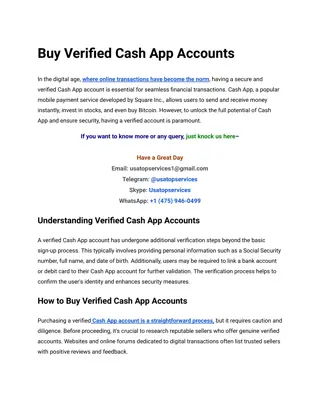
Uncle Rat's Bug Bounty Methodology Guide
Discover Uncle Rat's comprehensive bug bounty methodology guide including agenda, preparation tips, exploring requests, parameter analysis, and more to enhance your vulnerability testing skills effectively.
Download Presentation

Please find below an Image/Link to download the presentation.
The content on the website is provided AS IS for your information and personal use only. It may not be sold, licensed, or shared on other websites without obtaining consent from the author. If you encounter any issues during the download, it is possible that the publisher has removed the file from their server.
You are allowed to download the files provided on this website for personal or commercial use, subject to the condition that they are used lawfully. All files are the property of their respective owners.
The content on the website is provided AS IS for your information and personal use only. It may not be sold, licensed, or shared on other websites without obtaining consent from the author.
E N D
Presentation Transcript
Main app methodology BY UNCLE RAT
Agenda OS Command injection How to use this document CSRF Preperation Finding more endpoints Exploring the requests Parameter analysis Broken Access Control SQLi Business Logic Vulnerabilities SSRF
How to use this document
How to use this document 1. Use this document with the video for the main app methodology 2. First go through the intracies of bug bounties section, don't skip this 3. Make note of what parameters are tested for what vulnerabilities 4. Explore the vulnerabilities in their own sections 5. Practice your methodology to develop an intuition 6. Re-read this document 7. Imagine all the ways in which we can create impact with these vulnerabilties
Preperation Manually explore your target At least a couple of hours Uncle rat says: 8 hours + Keep Burp suite open in the background Scope set properly Will later on be used to explore the requests Make a mindmap of the functionality Take note of the privilege levels
Preperation Read any manual you can find Public info is never out of scope, so google! Register your accounts While you do use an XSS attack vector in every possible field Triggers integration issues if existent Also SSTI Ex. <img src=x> >${{7*7}} This will test for HTML injection This will test for JS context XSS This will test for HTML tag attribute injection This will test for SSTI This will test for CSTI
Exploring the requests
Exploring the requests Burp: Filter on all requests with parameters Study each request and parameter Think of what it does Think of how to break it functionally Does our bug have security impact if we find any?
Parameter analysis
Parameter analysis CSRF tokens should be checked JWT tokens should be checked Any URL that redirects people, even partial or in files (import) should be checked We have to test for BAC and IDOR if we see functions we should not be able to execute as a certain user Captcha s can be bypassed Files that are gotten from local system LFI or remote system RFI SQLi but in weaker form for every CRUD action XXE in SVG,XML,DOCX, Template injections via automated checks if you suspect templating engines
Parameter analysis URLs that resolve get checked for SSRF Every parameter gets checked for command injection Admin panels do not mean the end, try to bypass them
Issue types CSRF: Check if the token is present on any form it should be Server checks if the token length is correct Server checks if parameter is there Server accepts empty parameter Server accepts responds without CSRF token Token is not session bound
Issue types JWT: None-signing algorithm is allowed Secret is leaked somewhere Server never checks secret Secret is easily guessable or brute-forceable
Issue types Open redirect bypass: evil.com/expected.com Javascript openRedirects Hidden link open redirects Using // to bypass https:evil.com (browser might correct this, filter might not catch it) /\ to bypass %00 to bypass (null byte) @ to bypass Parameter pollution (adding the same parameter twice)
Issue types BAC Test higher Priv functions should not be able to be executed by lower Priv user Test ALL user levels Test with authorise S Functions via developer console Copy and paste of URL IDOR Test between ALL tenants (companies hosted on one server/database. Can also be divisions of companies) Test with authorise JS Functions via developer console Copy and paste of URL
Issue types Captcha bypasses Try change request method Remove the captcha param from the request leave param empty Fill in random value
Issue types LFI Using // to bypass /\ to bypass \\ %00 to bypass (null byte) @ to bypass URL encoding double encodings
Issue types RFI Using // to bypass /\ to bypass \\ %00 to bypass (null byte) @ to bypass URL encoding double encodings
Issue types SQLi: to trigger SQLmap XXE: SVG files (images), DOCX/XLSX, SOAP, anything XML that renders Blind SSRF, file exfiltration, command exec
Issue types Template injections (CSTI/SST) - ${7*7} - If resolves, what templating engine - Try exploit by looking at manuals URL encode special chars ({}*) HTML entities Double encodings
Issue types SSRF SSRF against server itself SSRF against other servers on the network Command injection Test every single parameter Make a list of commands + command separators for target OS Admin panel bypass Try referr header Easy username/pass Directory brute forcing for unprotected pages
Broken Access Control
Broken Access Control Some Terms Account = Organisation such as google for example User = Person such as an employee Preperation Create 2 accounts Invite at least 2 users per account Test for IDOR Between 2 accounts Between 2 users within 1 account
Broken Access Control Test for BAC Between all users from all privilege levels Within 1 account Within 2 users from different accounts Use tools Authorize Built for BAC testing Has more speciliased settings Auto repeater Less specialised Can be customised further
SQL Injection Test Every database read or write Basic check Enter ' and " wherever you can If you get a SQL error, run SQLmap Advanced check Investigate DB systems and build wordlist
Business Logic Vulnerabilities
Business Logic Vulnerabilities Whatever the manual tells you not to do, do it Mess with every single parameter and analyse results Look for the developer restraints and try to look for edge values I.E. if the developer wants us to rate from 1 to 5 Try 0 Try 6 Try 1 Try a Try ... Mess with the order of requests Copy parameters from the response to the request to see if they can be changed
Server Side Request Forgery
Server Side Request Forgery SSRF gives us access to internal servers we should not be able to access test any URL that gets resolved by the server and that we can control Partial URLs in the body instead of a full URL URLs within data files such as XML files or CSV files (import functionality) The referer header can sometimes contain SSRF defects Test for SSRF against the server itself SSRF against other backend systems Blind SSRF Requires extensive knowledge of the network or brute forcing
OS Command injection
OS Command injection
OS Command injection Input sometimes gets sent to back-end sh scripts This input needs to be properly sanitised The filtering is often blacklist based If developer forgets one thing on blacklist, we have an entry point Test Combine all command separators with all commands to make list Encode the list Test every single parameter Tool: Burp intruder + self created list
CSRF Test using match and replace Autorepeater plugin in burp CSRF scanner burp
CSRF Match and replace Add a match and replace rule Type: Request body Match: CSRF=* (replace this value with how your target does CSRF tokens) Replace: CSRF= << SEE NEXT SLIDE Regex match: True
CSRF Test techniques Remove the CSRF token from requests Replace the CSRF token with a random value (for example 1) Replace the CSRF token with a random token of the same restraints Leave CSRF Parameter empty Use a CSRF token that has been used before See if you can request a CSRF by executing the call manually and use that token for the request
Finding more endpoints
Finding more endpoints Javascript analysis Wayback URLs Google dorking API documentation






















